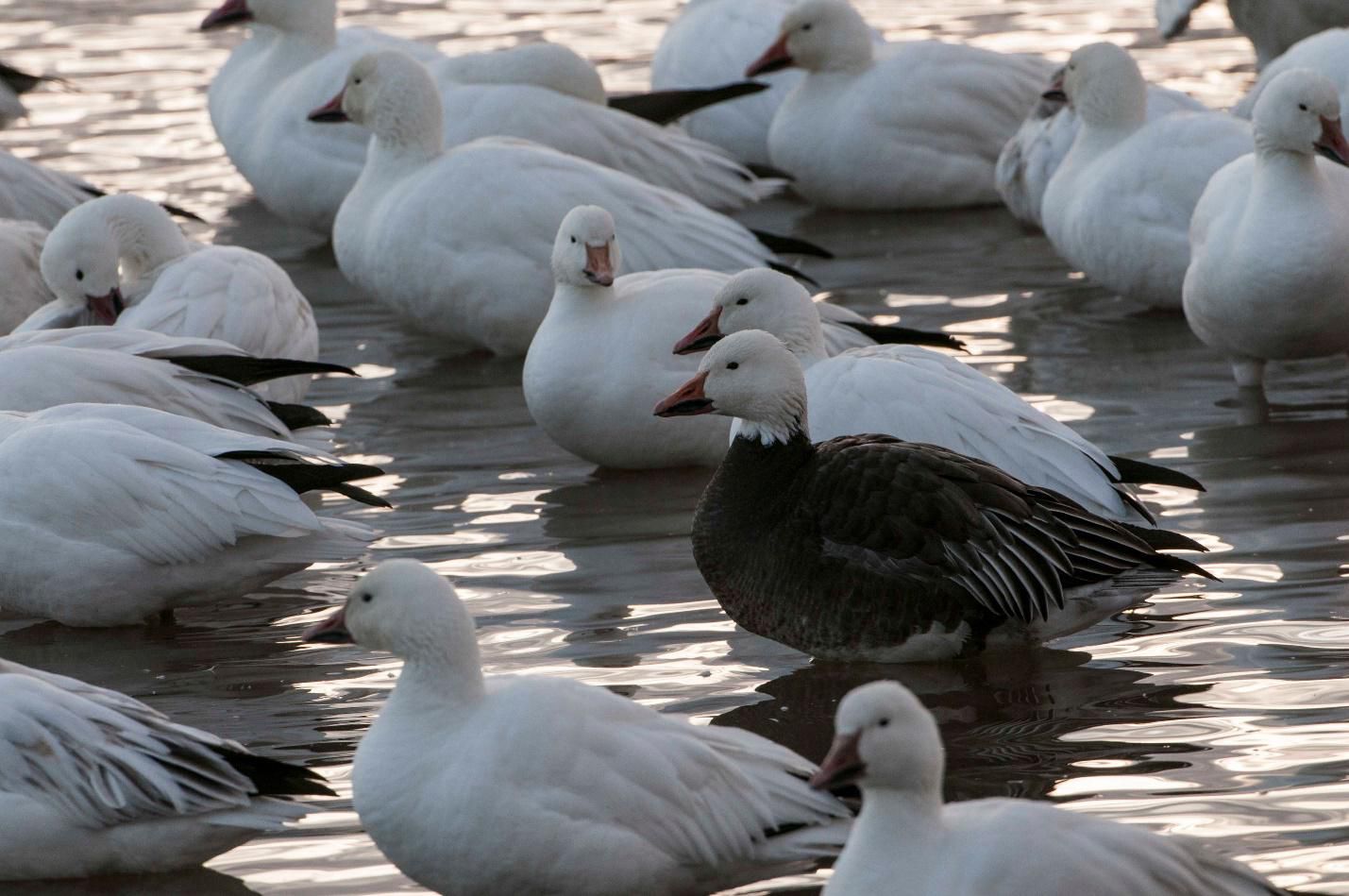During migration, snow geese are seldom found alone. Huge sky blotting flocks are often the norm.

White and blue morphs hang together, but usually choose the color morph they were raised with for a mate.
Snow Goose Anser caerulescens
General description:
A blizzard is coming soon. This spring storm will arrive sometime in the next few weeks in the form of thousands of white geese with black wingtips: snow geese. These are medium-sized geese, smaller than Canada geese and larger than mallard ducks. They have a pink bill with black lines or “lips” often called grin lines. The bill is short and seems to almost be an extension of the forehead. In comparison to Canada geese, the neck of the snow goose appears short and stout.
Behavior and Habitat
Snow geese are only spring visitors to Eastern Idaho. The closest wintering populations are at the Great Salt Lake, southwestern Arizona and Bosque del Apache National Wildlife Refuge in New Mexico. Breeding occurs on the shores of the Arctic Ocean, primarily in Canada.
It is a long way to the Arctic Ocean and snow geese are anxious to get there. Thus, they are some of the earliest migrators, sometimes arriving here when places like Camas, Mud Lake and Market Lake are still frozen. They are usually gone after mid-April so be sure to make time to see them before they go.
One of the awesome things about the snow goose migration is that snow geese like company. It is common to see flocks of a thousand or more and huge flocks are not uncommon. An estimated 50,000 or more snow geese usually pass through during the migration season.
When not roosting on water, you will find snow geese busily engaged gorging in waste grain in fields throughout the area.
Similar Species
There are plenty of species that sort of resemble the snow goose. Ross’s goose is likely the closest in size and shape. There is a white morph Ross’s goose that can fool the inattentive bird watcher. The Ross’s goose is smaller though, with a smaller bill that lacks the black “grin line” around the mouth.
Trumpeter and tundra swans have a similar white body, but are far, far larger. They also don’t have the prominent black wings, visible when the snow goose is in flight
Cool Facts
There are two snow goose color morphs: the vastly more common white version from which it takes its name, and the blue morph, a dark color usually mottled with white. What is interesting about the color morphs is that they choose mates of the same color morph they were raised with.
Snow geese are thought to mate for life.
During winter and migration, snow geese gather in great numbers at night to roost on water. It can be an inspiring event to witness fly-in in the late evening. You will have to be on the marsh before dawn to witness fly-out, where with a roar of wings and great vocalization the geese seem to lift off as one and head to the fields for the day.
When and where found at Camas NWR:
You will find snow geese on any pond that has water in the spring. That changes yearly, except for Sandhole Lake at the south end. It is usually full. It is a three-mile bike or hike though, so be prepared.
Conservation
“Snow Goose numbers have grown rapidly since the mid-twentieth century, possibly because of warming conditions in their arctic breeding grounds. Populations in the eastern and western arctic have tripled since 1973, and the central arctic population has grown by a factor of 25. These birds can be found breeding in the far north of Canada and winter principally in the U.S. and Mexico. Snow Geese are federally protected migratory game birds, and their hunting is managed on a population-by-population basis. The species is not on the 2014 State of the Birds Watch List. Throughout much of the twentieth century management officials restricted hunting in the interest of conservation, but by the 1970s they switched to worrying about keeping goose numbers in check. In the late 1990s both Canada and the United States began to permit extra hunting to reduce Snow Goose populations. About 400,000 Snow Geese are now hunted annually in the U.S. and Canada. Because Snow Geese nest in remote areas, their breeding
colonies have suffered little impact from humans. The geese themselves may degrade their own habitat by grubbing vigorously for food during the early breeding season, not only reducing their own breeding success but also compromising nesting shorebirds. Like many waterfowl, Snow Geese can suffer from lead poisoning when they ingest fallen lead shot while foraging. This problem can be reduced by switching to steel shot or other non-toxic ammunition.” https://www.allaboutbirds.org/guide/Snow_Goose/lifehistory
Text by Terry Thomas
Photo by Terry Thomas